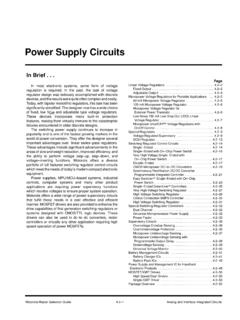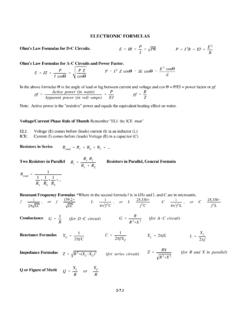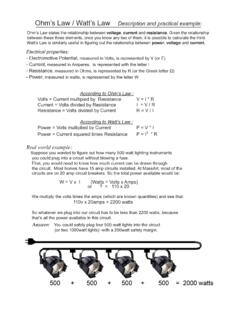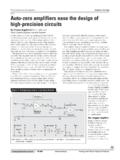Transcription of Unit 1. Electronic Principles - rcptv.com
1 unit 1. Electronic Principles 1 1. Electronics 1 1 201. Metric 1 1 202. Electronics 1 4 1 2. Electronic 1 12 203. Circuit 1 12 204. Types of circuits .. 1 19 205. Circuit configurations .. 1 20 206. Laws .. 1 22 1 3. Electronics Testing, Troubleshooting, and Repair .. 1 25 207. Electronic test equipment .. 1 25 208. 1 28 209. Electronics troubleshooting .. 1 34 210. Electronics preventive maintenance and repair .. 1 39 S AN AEROSPACE technician, you will often find yourself working with electrical systems and occasionally having to troubleshoot them as well. Therefore, having a thorough understanding of basic Electronic Principles will be essential somewhere in your line work. This unit contains lessons designed to help you understand the fundamentals of electronics as well as introduce some of the more common Electronic circuits and components you will be dealing with.
2 Our last lesson will introduce some common test equipment as well as circuit analysis and troubleshooting methods used in the field of electronics. 1 1. Electronics Fundamentals Before you can effectively troubleshoot an Electronic system, it is vital for you to understand some of the basic concepts and Principles of electronics. In this lesson we will be covering metric notation, electronics theory, some common electronics laws, and some basic Electronic circuits. Let s begin by looking at some numbering systems that will help make your job a little easier. 201. Metric Notation The field of electronics often involves measurements and mathematic calculations consisting of very large and very small numbers when analyzing electrical circuits. Working with these extremely large or small numbers can be a cumbersome chore; calculations often consist of unwieldy numbers, and decimal fractions can cause errors because of a misplaced decimal point or an accidental omission of a number.
3 Therefore, it is beneficial to convert numbers into different formats so that they are easier to work with. Powers of ten The powers of ten numbering systems are ways to express very large or very small numbers in more convenient formats. Basically, a whole or mixed number is expressed as the product of a factor and the appropriate positive power of ten. Powers of ten indicate a number s significant digits and its order of magnitude. Example: 123,000,000 = x 106 Likewise, a decimal fraction is expressed as the product of a factor and the appropriate negative power of ten. Example: = x 10 7 A 1 2 Powers of ten numbers are made up of the following parts: Coefficient The number before the multiplication symbol. (Example: is the coefficient of x 102). Base The number right after the multiplication symbol that is to be multiplied by itself.
4 When the number 10 is used as the base and matched with an exponent, it is called a power of ten. Exponent This is the superscript number next to the 10 and indicates the number of times 10 is multiplied times itself. This number also represents the number of places the decimal point shifts from the original number to where it ends up in the coefficient. If the decimal point moves to the left, the exponent will be positive. If the decimal moves to the right, the exponent will be negative. For example, the mass of the earth is about 5, 9 73,600,000,000,000,000,000,000,000 grams (g). That is a pretty big number to work with. To convert that to a power of ten, we first shift the decimal point to the left while counting each number of position changes. 5, 9 73,600,000,000,000,000,000,000,000 After moving the decimal point 27 places to the left, we end up with a coefficient of and a positive exponent of written in scientific notation, it is 1027 g.
5 How about an extremely small number? The mass of a proton is grams. To convert that to a power of ten, we first shift the decimal to the right while counting each number of position changes. After moving the decimal point 24 places to the right, we end up with a coefficient of and a negative exponent of 24. When written in scientific notation, it is x 10 24 g. To convert a powers of ten number back to its original format, simply reverse the above steps by counting the appropriate number of decimal spaces right or left of the coefficient, filling in zeros where needed. For example, to convert x 106 back to its original number, we would count six decimal spaces to the right (remember, move the decimal to the right if the exponent is positive and to the left if the exponent is negative), and we end up with 6,800,000.
6 Scientific Notation Scientific notation is a form of powers of ten numbering. Scientific notation uses the same basic procedures for manipulating numbers as powers of ten with one noticeable difference the final form expressed has a coefficient of greater than or equal to 1 but less than 10. To write a number in scientific notation, put a decimal after the first digit and drop the zeroes. The exponent will be the number of places from the decimal to the end of the number. Example: x 10 3 = x 10 2 Engineering Notation and Prefixes Engineering notation is another form of the power of ten numbering system that is more commonly used in electronics. Engineering notation is accomplished using the previous methods of moving the decimal point to any convenient position in the numerical coefficient as long as the resulting exponent is either zero or a multiple of three.
7 Exponents such as 9, 6, 3, 0, 3, 6, 9, and 12 allow you to express values with the International System of Units (SI) prefixes. Prefixes such as pico, mega, kilo, and so on simplify written and spoken expressions of electrical quantities. Table 1 1 shows several common powers of ten, their metric prefix, and metric symbol. 1 3 Table 1 1. Engineering notation and metric prefix. It s common practice to use prefixes to represent these quantities. Think of the metric prefix as a shorthand way to express a large or small number. Example: x 102 watts = x 103 watts = kilowatts Expressing powers of ten as different numbers What if your power of ten number does not contain the exact exponent you need to express it? You must know how to convert numbers between the different powers of ten.
8 For example, let s say you want to express the number x 102 in kilos (103)? To do this, you simply subtract the original exponent from the new exponent that you want to end up with. (3) (2) = 1 If the result is positive, you move the decimal point to the left by the number of positions equal to the result. x 103 The same rule applies if you want to express a power of ten number as a regular decimal number. Just subtract the original exponent from the new exponent (remember that 100 is used to represent the number one). Example: Express x 104 as a regular number. (0) (4) = 4 Since the result is negative, you now move the decimal point to the right the number of spaces equal to the result. 69,840 Performing calculations with powers of ten numbers The advantage of using power of ten notation is that it makes addition, subtraction, multiplication, and division of very large or small numbers easier.
9 Addition and subtraction To add or subtract numbers expressed in power of ten formats, the decimal point on either or both numbers must be adjusted until the exponents of the power of ten are identical. Addition or Decimals >/= 1 Positive Exponents Metric Prefix Symbol Decimals <1 Negative Exponents Metric Prefix Symbol 1 100 10 101 10 1 100 102 10 2 1,000 103 kilo K 10 3 milli m 10,000 104 10 4 100,000 105 10 5 1,000.
10 000 106 mega M 10 6 micro 10,000,000 107 10 7 100,000,000 108 10 8 1,000,000,000 109 giga G 10 9 nano n 1 4 subtraction of the numerical coefficients are performed as usual, and the power of ten will be identical to the common exponent. Multiplication and Division Multiplication and division of numbers expressed in power of ten formats are more straightforward. First, perform the desired calculation on the numerical coefficients as usual.




